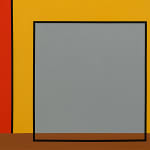Guy Vandenbranden
Guy Vandenbranden (Ixelles, 1926 - Antwerp, 2014) is a post-war Belgian artist.
Vandenbranden belongs to the second generation of constructivists, who follow in the footsteps of Piet Mondrian and Victor Vasarely to complete geometric abstraction.
Youth and education (1926-1950)
Guy Vandenbranden was born on July 14, 1926, in Ixelles, near Brussels. Six years later, the family moved to Mechelen. Vandenbranden attended Greek-Latin Humanities at the Royal Atheneum Pitzemburg. During World War II, Vandenbranden regularly visited exhibitions at the Brussels gallery Breughel, where he saw work by Constant Permeke, Gustaaf De Bruyne and Rudolphe Strebelle.
After aborting his studies in chemistry, Vandenbranden studies at a Brussels free academy that presumably has its roots in 'l'Effort'. Initially starting out as an expressionist, the artist paints landscapes and portraits in the style of Georges Rouault.
Abstract roads (1951-1957)
Around 1950, Vandenbranden was introduced to the work of Paul Klee. This moment defines his artistic life. Under Klee's influence, Vandenbranden continues to abstract his subjects. He sticks to abstract art for a career spanning over sixty years. In 1951, Vandenbranden exhibited at the important Saint Laurent gallery, where he met 'Brussels-based' artists such as Pol Bury and Jo Delahaut.
In 1952, Vandenbranden got a solo exhibition at Galerie Iris in Antwerp. Later, exhibitions followed at Kunstkabinet Horemans, the gallery of art critic K.L. Elno. These are his first exhibitions in the city where he lived for more than half a century. In late January 1954, Guy Vandenbranden got to know the work of Victor Vasarely at an exhibition at the Palace of Fine Arts in Brussels. His own work becomes more complex and completely geometric during this period.
In 1956, Vandenbranden joined the artists' group Art Abstrait, founded in 1952 by Pol Bury, Jo Delahaut and Jan Saverys, among others. His coming of age as an abstract painter was then a fact. Meanwhile, the painter, still living in Mechelen, made more and more contacts with the Antwerp art scene. He gets to know Jef Verheyen, Paul Van Hoeydonck and Mark Verstockt, with whom he maintains a friendship of more than sixty years.
Contacts with the Zero movement (1958-1965)
In the late 1950s, Vandenbranden became fascinated by black and arrived at an almost complete monochromy. Despite his fondness for the "black surface", he sticks to constructivism by placing white cut-outs in his otherwise black canvases. In doing so, Vandenbranden achieves a special tension. It is during this period that Vandenbranden makes plans with monochrome painter Jef Verheyen to create an international avant-garde gallery in Antwerp.
In 1958, partly due to the artists' collective G58, the centre of the Belgian art scene shifted from Brussels to Antwerp at a rapid pace. Vandenbranden moved permanently to Antwerp in 1960, where he worked with Paul van Hoeydonck and Jef Verheyen, among others.
In 1959, Vandenbranden exhibited with Paul Van Hoeydonck at the Galeria Pater in Milan. Here, Vandenbranden gets to know international artists, including Lucio Fontana, Piero Manzoni and Yves Klein, personally.
Guy Vandenbranden befriends Zero group artist Jan Henderikse in the late 1950s, who states in an August 2015 interview that Vandenbranden is his only link to the G58 milieu.
In 1961, a major piece on Vandenbranden's work appeared in 'Zero' (U.S.A. edition) No.4.
Assemblages (1961-1966)
From 1961, partly in response to Nouveau réalisme, Vandenbranden wanted to add depth to his work. He makes constructivist assemblages of thonet chairs. Vandenbranden wants to make the viewer think about the plasticity of the object. With these assemblages, Vandenbranden exhibited at the high-profile Forum exhibition in Ghent (1963), which also featured work by Gunther Uecker and Tinguely.
Lacquer works (1966-1980)
In the mid-1960s, Vandenbranden converted his 3D discoveries into a pictorial language on panel. The distorted perspectives are sprayed directly onto panels with automotive paint to accentuate the hardness. Vandenbranden has become a full-fledged Hard-edge artist. During this period, Vandenbranden helped shape the artistic programme of the Antwerp artist association V.E.C.U.
Guy Vandenbranden co-founded the 'Internationaler Arbeitskreis für Konstruktive Gestalltung (IAFKG)' in 1972. Members besides Vandenbranden include Schrader, De Poortere and François Morellet. The group held six symposia from 1976 to 1983.
Another official recognition followed in 1980 when Vandenbranden was included in the Europalia exhibition 'Belgium-Netherlands, Junctions and parallels in art after 1945'.
Later years
During the 1980s, 1990s and 2000s, many more exhibitions and retrospectives followed at home and abroad. In 2002, after almost forty years, Vandenbranden traded in his large studio the Scheldeken for a smaller studio in Deurne. He continued painting unabated with acrylic on smaller canvases.
On the 4th of June 2014, Guy Vandenbranden died in Antwerp just before the publication of his monograph. He is buried on the lawn of honour at Schoonselhof cemetery.
Literature
Guy Vandenbranden,Callewaert-Vanlangendonck Gallery, David Vermeiren; G58 en ZERO, Europeanen avant la lettre; Bénézit, E.; Pas, W. & G. - Arto 2000



